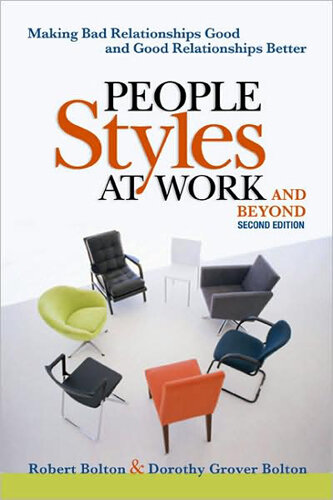Robert Bolton and Dorothy Grover Bolton, People Styles at Work…And Beyond: Making Bad Relationships Good and Good Relationships Better. Amacom, 2009.
Referenced in: Strengths-Based Leadership
LifeandLeaderhsip.com Summary
This uses the People Styles Model to show how people with different styles interact with each other in work environments. People Styles is similar to the DISC personality assessment which is featured on LifeandLeadership.com, with the following correlation:
- Driver – equivalent to D or Dominant in DISC
- Expressive – equivalent to I or Influencing in DISC
- Amiable – equivalent to S or Steady in DISC
- Analytical – equivalent to C or Conscientious in DISC
Part One explains the people styles model, helps readers understand their natural style, and how their differences with others can create difficulty. This includes chapters to help each style see how it comes across to others and understand strengths and weaknesses. One chapter describes the backup styles – the four dysfunctional and relationship-straining ways in which people of each style react to excessive stress. This is followed by a chapter on how to cope with one’s own and others’ stressed-out behavior.
Part Two: Style Flex, is one of the best sections of the book. It shows how to adjust one’s behavior to each style. “Style flex is the intriguing ability to be true to yourself while relating to someone else on that person’s wavelength.” (2) This involves four steps:
- Identify – Know your own style and the style of the other person.
- Plan – Select the behaviors to change in order to get more in sync with the other person’s preferred ways of doing things.
- Implement – Do the changes selected in step 2.
- Evaluate – “Take the pulse” during exchanges to see if midcourse corrections are needed. After the meeting, mentally review the process and the outcome in order to learn from the experience.
Part Three is a great application of People Styles in the realm of family relationships. This includes a chapter “The Art of Loving Someone Very Different from Yourself,” and another chapter on style-based parenting guidelines.
There are four appendices, one for each of the four styles, offering specific guidelines how to how to flex to persons for each of the four styles.
- Appendix I For Amiables Only: How to Flex to Each Style
- Appendix II For Drivers Only: How to Flex to Each Style
- Appendix III For Expressives Only: How to Flex to Each Style
- Appendix IV For Analyticals Only: How to Flex to Each Style
From the Publisher
Why is it so hard to work well with some people? People Styles at Work…and Beyond presents a comprehensive, practical, and proven method readers can use to:
- Recognize how they come across to other coworkers
- Read others’ body language and behavior to identify the best ways to work with them
- Make small adjustments that will dramatically increase the quality and productivity of their interactions
- Find common ground with different people while retaining their individuality
- Relate less defensively and more effectively—no matter how others act
The book reveals the strengths and weaknesses of four different people styles, providing practical techniques that work both on the job and off. Now including all new material on personal relationships, parenting, and more, this is the ultimate guide anyone can use to enhance even the most difficult relationships.
About the Authors
Robert Bolton and Dorothy Grover Bolton (Cazenovia, N.Y) are co-founders of Ridge Associates, which specializes in people skills training, leadership development, interpersonal communication, and performance management. Their training and coaching clients include many Fortune 500 companies and executives. They are the authors of Social Style, Management Style.
***For additional information on this resource, including reviews, click the bookstore links. Check the reference at page top or the links below for resource guides on related topics.***
Related Areas
See Other Resources on Strengths-Based Leadership:
See Other Resources on Leadership in General:
See Resources on Over 100 Areas of Ministry Leadership:


